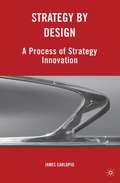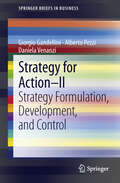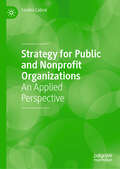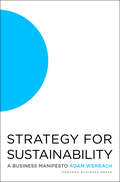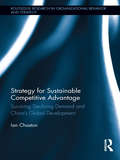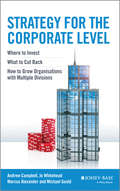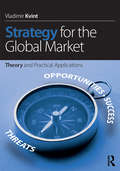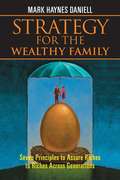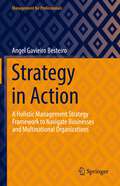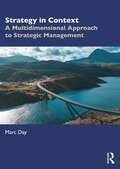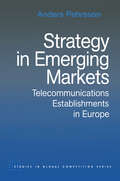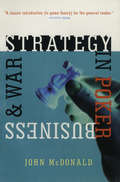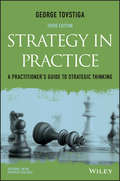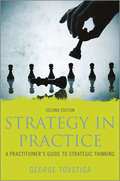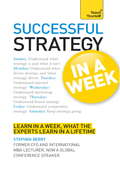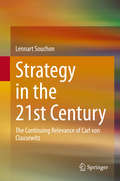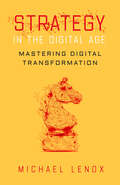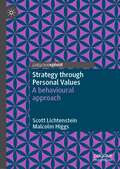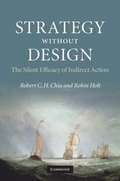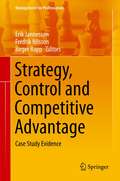- Table View
- List View
Strategy as a Portfolio of Real Options
by Timothy A. LuehrmanIn this article, Timothy A. Luehrman explores how option pricing can be used to improve decision making about the sequence and timing of a portfolio of strategic investments. In financial terms, a business strategy is much more like a series of options than like a single projected cash flow. Executing a strategy almost always involves making a sequence of major decisions. Some actions are taken immediately while others are deliberately deferred so that managers can optimize their choices as circumstances evolve. While executives readily grasp the analogy between strategy and real options, until recently the mechanics of option pricing were so complex that few companies found this method practical to use when formulating strategy. But advances in both computing power and our understanding of option pricing over the last 20 years now make it feasible to apply real-options thinking to strategic decision making. To analyze a strategy as a portfolio of related real options, this article exploits a framework presented by the author in "Investment Opportunities as Real Options: Getting Started on the Numbers" (HBR July/August 1998). That article explained how to get from discounted-cash-flow value to option value for a typical project; in other words, it was about reaching a number. This article extends that framework, exploring how, once you've worked out the numbers, you can use option pricing to improve decision making about the sequence and timing of a portfolio of strategic investments. The author shows executives how to plot their strategies in two-dimensional "option space," giving them a way to "draw" a strategy in terms that are neither wholly strategic nor wholly financial, but some of both. Such pictures inject financial discipline and new insight into how a company's future opportunities can be actively cultivated and harvested.
Strategy by Design
by James CarlopioStrategy by Design illustrates how to use many of the principles, processes and tools of the design profession to create innovative break-through organizational strategies.
Strategy for Action – I
by Daniela Venanzi Alberto Pezzi Giorgio GandelliniThe innovative and unique feature of this book is that it does not contain theoretical concept that cannot be translated into practice. The model which introduces this volume sets the stage for addressing the major phases of the strategic management process: environmental analysis, strategy formulation and development, strategy evaluation and control. Its conceptual and operational structure is described in the first part, together with a practically oriented definition of strategy, and a brief discussion of the logic and benefits of the judgmental modeling approach to decision making. The second part critically addresses the classical approaches to the analysis of the external and internal environmental factors, which have an impact on the "functioning" of the basic model, i.e. the structural characteristics of the industry context, and the companies' technical, organizational, financial, and human resources, including the translation into operational models of otherwise rather theoretical concepts.
Strategy for Public and Nonprofit Organizations: An Applied Perspective
by Sandro CabralThis book examines why strategy matters in public and nonprofit organizations, as well as in private firms with the potential to create (or destroy) public value. Combining a solid conceptual basis in strategy, it focuses on understanding the drivers of superior performance and public value creation and appropriation by a myriad of stakeholders. Readers will gain insights into the core strategic conditions that can make sense in the public and nonprofit sectors as well as in cross-sector collaborations. This book will contribute to existing conversations on the importance of strategic thinking in policy debates and broader social issues.
Strategy for Sustainability
by Adam WerbachThe definitive work on business strategy for sustainability by the most authoritative voice in the conversation.More than ever before, consumers, employees, and investors share a common purpose and a passion for companies that do well by doing good. So any strategy without sustainability at its core is just plain irresponsible - bad for business, bad for shareholders, bad for the environment. These challenges represent unprecedented opportunities for big brands - such as Clorox, Dell, Toyota, Procter & Gamble, Nike, and Wal-Mart - that are implementing integral, rather than tangential, strategies for sustainability. What these companies are doing illuminates the book's practical framework for change, which involves engaging employees, using transparency as a business tool, and reaping the rewards of a networked organizational structure.Leave your quaint notions of corporate social responsibility and environmentalism behind. Werbach is starting a whole new dialogue around sustainability of enterprise and life as we know it in organizations and individuals. Sustainability is now a true competitive strategic advantage, and building it into the core of your business is the only means to ensure that your company - and your world - will survive.
Strategy for Sustainable Competitive Advantage: Surviving Declining Demand and China's Global Development (Routledge Research in Organizational Behavior and Strategy)
by Ian ChastonDue to the adverse outcomes of the recent global recession and the public deficit crisis in the USA and Europe, Western companies can expect flattening or declining sales in their domestic markets. They will also face growing competition as Chinese firms seek to block the activities of foreign companies in their domestic market and expand their own operations in overseas markets. Survival and growth for Western companies is unlikely to come from sustaining current business practices based upon utilization of conventional approaches to strategic management; success will depend on exploiting new knowledge to stay ahead of competition. This book examines the strategic issues associated with the entrepreneurial utilization of new knowledge to create innovative products and services, accompanied by the development of leading edge, highly productive internal organizational processes. Through the use of appropriate theories and illustrative case examples, the text is designed to assist managers in Western organizations and business school students understand how to counter the increasing threats that are posed by the globalization of companies from emerging countries such as the BRIC nations.
Strategy for the Corporate Level
by Jo Whitehead Marcus Alexander Andrew Campbell Michael GooldA revised edition of the bestselling classicThis book covers strategy for organisations that operate more than one business, a situation commonly referred to as group-level or corporate-level strategy. Corporate-level strategy addresses four types of decisions that only corporate-level managers can make: which businesses or markets to enter, how much to invest in each business, how to select and guide the managers of these businesses, and which activities to centralise at the corporate level. This book gives managers and executive students all the tools they need to make and review effective corporate strategy across a range of organisations.
Strategy for the Global Market: Theory and Practical Applications
by Vladimir KvintIn the twenty-first century, the global community constantly strives to bring structure and order to the world through strategic means. From the highest levels of governments and militaries to multilateral institutions, NGOs, and corporations, a strategy for the future of a company, region, country, or even the world is tantamount to success. Yet few understand what strategy actually is and how it can be developed, planned, and implemented. Strategy for the Global Market combines a fundamental study of the theory of strategy with its practical applications to provide a new approach to the global emerging market. Due to the technological transformations in communications and transportation, and the birth and development of both the global community and the global marketplace over the past twenty years, the world’s population and corporations are in much closer contact with their counterparts across the globe than ever before. This has led to increasing competition and even rivalries. Understanding the strategic environment, as well as solving problems either through amicable means or conflict, requires the powerful instrument of strategy to remain efficient and to triumph.? Features of this book include: Methodology and practical recommendations for all stages of developing and implementing strategy. A comprehensive guide with explanations and descriptions, for the preparation and orderly compilation of all necessary strategy documents. Real-world examples taken from corporate, government, and military strategizing practices in emerging market countries and the global marketplace. This book should be on the desk of every national, regional, and military leader, corporate executive, manager, and student of strategy.
Strategy for the Wealthy Family
by Mark Haynes Daniell"An excellent and comprehensive approach to the strategies required to understand, protect and grow family wealth across generations. " John Evans Managing Editor Private Banker International "Strategy for the Wealthy Family expands the field of wealth planning and management by exploring beyond just financial concerns to consider critical human issues such as philanthropy and family leadership. " Professor Randel S. Carlock, Ph. D. , INSEAD Business School Berghmans Lhoist Chaired Professor in Entrepreneurial Leadership Director, Wendel International Centre for Family Enterprise "The first book I have ever seen which fully addresses the all-important human side of the wealthy family as well as the financial aspects of family wealth management. . . an important book for any family, no matter how much wealth they have. " Vivian Imerman Entrepreneur "Strategy for the Wealthy Family is a brilliant source of insight and information covering all aspects of family wealth management. This book is a perfect companion for private bankers, wealth managers, and wealthy families. " Christopher Wilson Managing Partner Family Office Trust ". . . a complete work of art for the wealthy. " R Jayachandran Chairman Aquarius Investment Advisors
Strategy in Action: A Holistic Management Strategy Framework to Navigate Businesses and Multinational Organizations (Management for Professionals)
by Angel Gavieiro BesteiroHow to develop best-practice strategy in a business or a multinational organization? Putting in value the strategy function and embracing a Holistic Management Strategy (HMS) framework would unleash performance for any business or organization. This book illustrates with real examples the HMS, a set of 10 frameworks that provide best-practice to design and develop strategy. The HMS approach is differentiated between business unit and divisional/group level, and adapted to situations of existing versus new markets and organic versus inorganic growth. The book introduces new topics such as integrated business model and strategy & financial plan at business unit level, attractiveness and opportunities framework for new markets linked with inorganic growth, portfolio horizons connected with the company’s market valuation gap, leadership & management excellence programme (e.g. THICOSIV), company excellence based on a balanced designed and considered decision-making, the future of the strategy function, and seven meta-architectural levers to successfully address digital disruption.
Strategy in Context: A Multidimensional Approach to Strategic Management
by Marc DayStrategy in Context represents a pragmatic and novel approach to competitive strategy and strategic thinking. It makes use of numerous examples across the public and private sectors to demonstrate strategy from three dimensions–external context, internal context, and an organisation-specific context.This exciting new textbook explores different ways of thinking about strategy, balanced and underpinned throughout using a pragmatic perspective to address real-world strategic issues. Each chapter includes real-life short cases from a variety of sectors and regions, designed to demonstrate how theoretical concepts are used to resolve practical challenges. Through this multi-dimensional approach, this book encourages managers to be more creative and ambidextrous in their strategic thinking, harnessing the power of context to leverage the best from their organisation’s resources and capabilities.This textbook is suitable as both recommended and core reading for postgraduate, MBA, and executive students of Strategic Management. Online resources include PowerPoint slides and a test bank.
Strategy in Emerging Markets: Telecommunications Establishments in Europe (Routledge Studies in Global Competition #Vol. 8)
by Anders PehrssonMarkets which have been previously out-of-reach for companies other than monopolies or other protected firms, are increasingly being opened up to new entrants. Greater competitive pressure implies that more sophisticated business strategies must be formulated by all companies cooperating in emerging markets.This book focuses on strategy in emerging telecommunications markets in a liberalized Europe, particularly in the UK and Sweden. The book provides:* a literature review and applications of strategy concepts and key correlations* applications of a market establishment model and the strategic states model* a description of competition amongst telecom operators in the UK and Sweden* detailed case-studies of strategies of telecom operators in Europe* the identification of patterns and processes valid for emerging markets in general.Whilst the industry focus in the book is telecommunications, the framework and the models explored and developed provide guides to strategy formulation irrespective of the market under consideration.Strategy in Emerging Markets will make valuable reading for strategy researchers, students and for corporate strategists. It will be of particular interest to those wishing to plot recent developments in the telecommunications industry.
Strategy in Poker, Business & War
by John McdonaldWhether your primary interest is to improve your card game or put together a political coalition, here you will be enjoyably instructed in an approach to strategy that has caught the imagination of a generation of readers. John McDonald looks at the elusive thread of opposition and conflict that runs through human interrelationships, from the striking of a bargain to the clash of war. He discusses poker; game theory, as it applies to games but mainly to business; the strategies of buyers and sellers; and finally military and other applications.
Strategy in Practice
by George TovstigaStrategy in Practice presents a practitioner-focussed approach to strategy. Rigorously founded on current thinking and theoretical concepts in the field of strategic management, it aims to: Provide the strategy practitioner with a systematic and insight-driven approach to strategic thinking.Establish and translate the relevance of strategy theory to its application in the practice field. This is where many executives in firms have great difficulty: they lose sight of the wood for the trees when it comes to strategy.Leads the reader through the strategic thinking process, beginning with the formulation of compelling and clearly articulated strategic questions and an appropriate analysis of the relevant issues.The book offers students and executives the tools they need to develop insight or 'get the big picture' on the basis of limited information and fast reaction to unexpected crisis. Its concise format will make it a popular primer for all readers.
Strategy in Practice: A Practitioner's Guide to Strategic Thinking
by George TovstigaThe 2nd edition of Strategy in Practice presents a practitioner focused approach to strategy. It is increasingly recognised that the ability to adapt classic formulas to changing circumstances and develop fast, sound strategic thinking is what differentiates the successful corporate leader. Developed from experience in industry this successful text will include an instructor site with PowerPoint slides, extra examples and exercises, and links highlighting changing business practice. While rigorously founded on current thinking and theoretical concepts in the field of strategic management it aims to: • provide the strategy practitioner with a systematic and insight-driven approach to strategic thinking • establish and translate the relevance of strategy theory to its application in the practice field • lead the reader through the strategic thinking process, beginning with the formulation of compelling and clearly articulated strategic questions that set the scene for practical issues • provide tools of strategic analysis in combination with informed intuition to understand the strategic landscape.
Strategy in a Week: Teach Yourself Ebook Epub
by Stephen BerryThe ability to develop and implement a successful strategy is crucial to anyone who wants to advance their career. Written by Stephen Berry, a leading expert on strategy as both a coach and a practitioner, this book quickly teaches you the insider secrets you need to know to in order to build a winning strategy. The highly motivational 'in a week' structure of the book provides seven straightforward chapters explaining the key points, and at the end there are optional questions to ensure you have taken it all in. There are also cartoons and diagrams throughout, to help make this book a more enjoyable and effective learning experience. So what are you waiting for? Let this book put you on the fast track to success!
Strategy in the 21st Century Pharmaceutical Industry: Merck & Co. and Pfizer Inc.
by David J. Collis Troy SmithThe global pharmaceutical industry has gone through substantial changes in the last few decade and pharmaceutical firms face major challenges, including headline-grabbing litigation, imminent patent expirations, new technologies, rising drug development costs, generic drug substitution, international competitors, and complex public policy issues. Describes the pharmaceutical industry in 2006, including: the drug development process; threats from biotech and generics competitors; pharmaceutical manufacturing, selling, and marketing; and pharmaceutical consumption in Europe, the third world, and the U.S. Merck and Pfizer are analyzed in-depth and a contrast between Merck, as a research-based firm opposed to mergers, and Pfizer, as a marketing powerhouse growing through acquisitions, is developed. Thirteen exhibits give concrete focus to the issues of the case.
Strategy in the 21st Century: The Continuing Relevance of Carl von Clausewitz
by Lennart SouchonThis book presents a detailed discussion of Clausewitz's principal lines of thought and methods of implementation. It elaborates on his main objective of laying a foundation for the education of up-and-coming creative, knowledgeable and experienced future leaders. The book encourages reflection and study in strategic thinking in order to transform knowledge into genuine capability. The book explores the question of what a twenty-first-century decision-maker can learn from these strategic lines of thought. It bridges the gap between philosophical theory and strategic interaction in conflicts with an equal opponent. Readers learn to understand and employ the clash of wills, attack and defence, and friction, and in essence the necessary virtues of a strategic commander.The findings presented help to identify the essential features in complex decision-making situations and developing possible courses of strategic action from a holistic standpoint. As such, the book is a must read for strategists, business practitioners, and scholars of political leadership and management interested in a better understanding of strategy and decision-making.
Strategy in the Age of Disruption: A Handbook to Anticipate Change and Make Smart Decisions
by Henrik Von Scheel Ciprian Popa Joshua Von ScheelSeize your place in a new era in commerce and industry In Strategy in The Age of Disruption, a team of dedicated strategists delivers an exciting and practical guide to Industry 4.0, a commercial transformation that’s impacting every facet of the market, the environment, and our social lives. You’ll learn what Industry 4.0 is, what it means for you and your company, and how you—as a leader, manager, expert, entrepreneur, or investor—can capitalize on it and put it into practice. This is a complete handbook on strategic execution. It’s a step-by-step tutorial designed to get you to clearly see your strategic position, the choices available to you, and how to execute on those choices. You’ll also find: Ways to move beyond outdated business models that no longer serve the companies that follow them Common myths about strategy and how to put them to bed for good Deep and insightful explanations of the fourth industrial revolution and what it means for your sector and companyHighly visual and endlessly engaging, Strategy in The Age of Disruption will systematically guide you through how to manage the challenges of the present and the promise of the future.
Strategy in the Age of Superabundant Capital
by Karen Harris David Harding Michael Mankins"What’s Changed? For most of the past 50 years, business leaders viewed financial capital as their most precious resource. But today it is abundant and cheap. What Does It Mean? The skillful allocation of financial capital is no longer a source of sustained competitive advantage. More important is a workforce that can generate good ideas and translate them into successful new products, services, and businesses. What Should Firms Do? Companies should lower hurdle rates, make numerous small investments in growth opportunities, and pay more attention to managing their human capital well."
Strategy in the Digital Age: Mastering Digital Transformation
by Michael LenoxDigital transformation is much more than building a digital infrastructure to gather and process data. It is about understanding how digital technologies enable the creation of innovative services and products. It is about identifying new competitive positions and business models and thinking critically about how to both create and capture value. Strategy in the Digital Age directly engages these concerns and provides a comprehensive roadmap for planning a successful digital strategy and executing a digital transformation in organizations. Covering major topics such as big tech, data analytics, artificial intelligence, blockchain, cryptocurrency, autonomy, cybersecurity, data privacy, and antitrust, strategy expert Michael Lenox outlines a set of novel, original frameworks to help those undertaking digital transformation at their organization devise their strategy. Readers will also come away with a greater understanding of how to navigate the human dimension of digital transformation and tackle the numerous social and policy challenges raised by digital technology. With insights from major companies such as Spotify, Facebook, and Uber, Lenox delivers a compelling volume that offers both a foundational understanding of this dynamic environment and an action plan for those seeking a path to digital strategy implementation for their organization.
Strategy through Personal Values: A behavioural approach
by Malcolm Higgs Scott LichtensteinProviding an alternative to short term, bottom line thinking this book enters into a deeper dialogue about the role of personal values in strategy formulation and implementation.Personal values are at the core of people’s personality. They influence the choices we make, the people we trust, the appeals we respond to, and the way we invest our time and energy. In turbulent times, values give a sense of direction amid conflicting views and demands. This book summarises current research in this area and introduces a new model around what personal values guided strategy is, how it’s linked to strategic choice and organizational goals and how it impacts upon organizational performance. Once personal value systems are recognized, personal value systems and their alignment to strategies, goals and missions provide powerful insight into how resistance to strategies is caused. With implications for leadership development, corporate governance and strategic HRM, this book extends research in this area and is essential reading for anyone involved in strategy implementation.
Strategy vs. Tactics from a Venture Capitalist
by Arthur RockA leading venture capitalist--who looks at people, particularly financial people, rather than at the financial projections in business plans--sets forth his beliefs as to how entrepreneurs can create successful, thriving enterprises. They must be brutally honest with themselves, accepting bad news and staying on top of disappointing developments. At the same time, they must believe in their ideas; understand how vital good management is to their company; if they can't provide it themselves, bring the right person in; be skilled managers who can be tough-minded with themselves and their team, can say "no," and ideally, are well versed in the technology on which the company is based.
Strategy without Design: The Silent Efficacy of Indirect Action
by Robert C. H. Chia Robin HoltStrategy exhibits a pervasive commitment to the belief that the best approach to adopt in dealing with affairs of the world is to confront, overcome and subjugate things to conform to our will, control and eventual mastery. Performance is about sustaining distinctiveness. This direct and deliberate approach draws inspiration from ancient Greek roots and has become orthodoxy. Yet there are downsides. This book shows why. Using examples from the world of business, economics, military strategy, politics and philosophy, it argues that success may inadvertently emerge from the everyday coping actions of a multitude of individuals, none of whom intended to contribute to any preconceived design. A consequence of this claim is that a paradox exists in strategic interventions, one that no strategist can afford to ignore. The more single-mindedly a strategic goal is sought, the more likely such calculated instrumental action eventually works to undermine its own initial success.
Strategy, Control and Competitive Advantage
by Fredrik Nilsson Erik Jannesson Birger RappHow should firms' control systems be designed and used to formulate and implement strategies that will contribute to competitive advantage and sustained high performance? This book offers some thought-provoking suggestions. It contains empirical studies of such diverse manufacturing enterprises as Atlas Copco, Electrolux, Saab, Scania, SCA Packing and Volvo, as well as an insurance company and two chamber orchestras. All firms and organizations presented offer interesting and exciting insights, each in a specific way and each with a fascinating history. The book presents research on the relationship between strategy, control and competitive advantage over extended periods and at several strategic levels, while also taking into account the existence of multiple control systems in a single firm or other organization. Readers are offered an in-depth look into how changes in the environment lead to adjustments in strategies and control systems. It is shown, in addition, how difficult and challenging it can be to implement these changes, and why such efforts are not always successful. But perhaps most importantly, the book conveys an in-depth understanding of how strategies and control systems affect competitive advantage and performance. In both its coverage and focus, the book is unique. Not only does it provide valuable contributions to the research field of strategy and management control; it also represents a substantial commitment in terms of resources and involvement over an extended period. The book is highly recommended to researchers, practitioners, graduate students and all others interested in this area.

